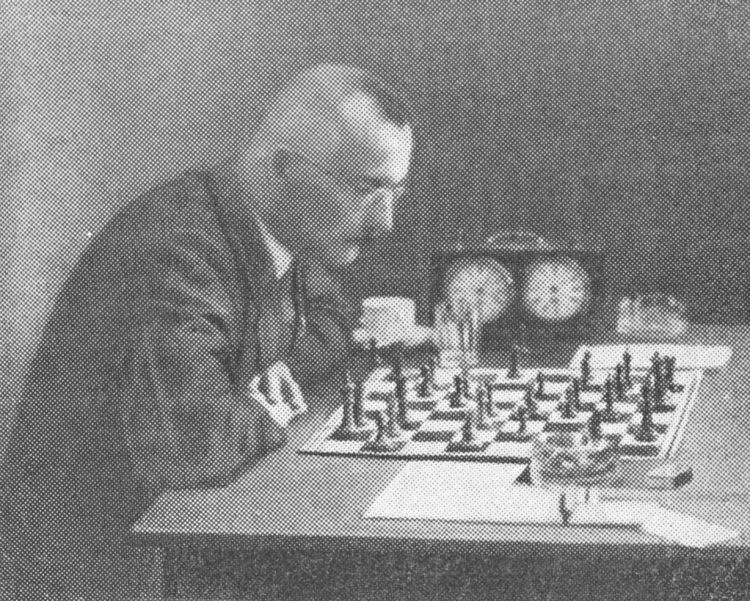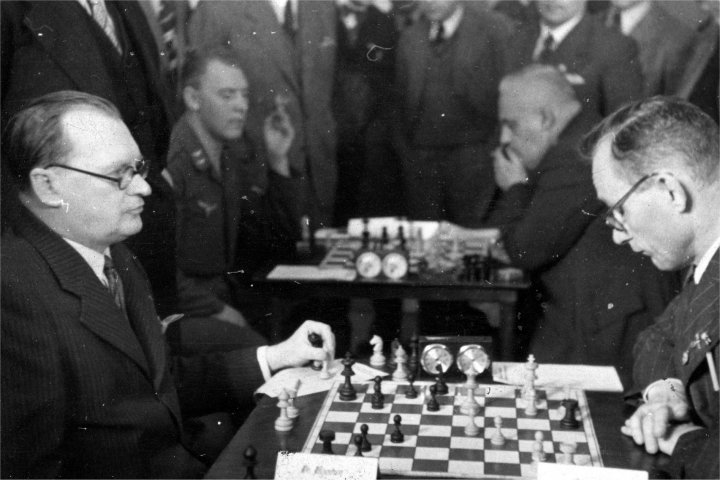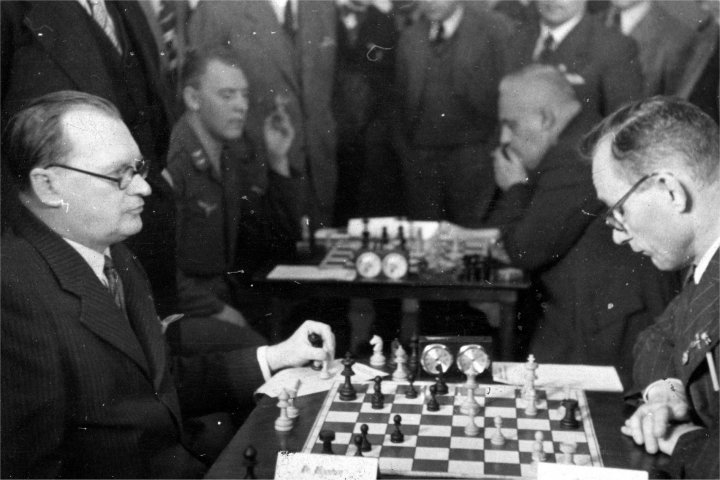The game
As the ChessBase Mega Database reveals, Blümich and Alekhine played each other in the eleventh and final round of the 1941 Krakow/Warsaw tournament. Alekhine won a nice attacking game with Black, in which he resorted to a variation of the Caro-Kann Defence, which recently has become popular again.
The ChessBase Mega Database 2021 is the premiere chess database with over 8.4 million games from 1560 to 2020 in high quality.
With this win Alekhine also won the tournament though he had to share first place with Paul Felix Schmidt. Both scored 8.5/11 and were one point ahead of Efim Bogoljubow and one and a half points ahead of Klaus Junge.
Krakow/Warsaw 1941, final standings after 11 rounds
As the table shows, Alekhine did not suffer a single loss, whereas Schmidt lost two games: one against Georg Kieninger and one against Alekhine. The two later tournament winners, Schmidt and Alekhine, met each other in the fourth round and in this game Schmidt had what he later described as his most "unforgettable chess experience". According to Schmidt, Alekhine in this game "moved a rook and just took the move back". (See Eva Regina Magacs, Michael Negele, Paul Felix Schmidt: A Winning Formula, Exzelsior Verlag, Edition Randstein 2017, p. 106).
What happened?
Alekhine shared his version of the events in this game with Francesco Lupi, who then retold Alekhine's tales to the chess public in the British magazine CHESS. Alekhine probably overlooked the simple mate after 31.Rb8+ because he had drunk too much cognac during the game. In his account of the incident Alekhine more or less openly admits that he was drunk during the game, but he provides a different explanation for the "J'adoube" on move 32.
I hadn't tasted ...coffee... for long enough, but the Governor of Poland made the tournament players a present of several bottles. Well, my game against Schmidt was a bit involved but I had it all worked out satisfactorily and I began to think less and less about the game and more and more about the coffee I drank, and yet I got nearer and nearer to a win. Finally I returned to the board, somewhat confused perhaps by the effects of the 'coffee' and assuming that Schmidt had made the one move which would avert mate in two, I made to seize a rook and make my reply. But then I perceived that Schmidt had not seen the danger and had left the mate on. I cried at once "J'adoube". Immediate pandemonium! Everybody seemed to be arguing at once. I offered Schmidt the choice of a draw or making me move with the rook in question. Post, the tournament director, retired with the committee to consider the case.
Whilst they were still in conference, I saw one of the other players rise and speak mysteriously in Schmidt's ear, waving his hands about whilst the latter nodded wisely. Schmidt went out and, I think, spoke to Post. Anyway, they all returned together and Schmidt said he refused the draw and would like to play on, I to move the rook. Having still the better game, I worked up a nice finish and with a most dolorous face, Schmidt resigned about an hour later. Only afterwards did I hear why he refused the draw. His advisor had said to him, "Don't be a fool! Go for the full point! Can't you see he's so completely drunk that he couldn't see a mate in one, let alone in two!" (CHESS, April 1947, p. 205, quoted in Negele/Magacs, Paul Felix Schmidt, p. 294-295)
But anyone who looks at the game, quickly realises that this version of events cannot be correct. After all, Alekhine's "J'adoube" came on move 32, when he had touched the rook on c1 in order to move it to c8. According to Alekhine's version, "[he] had to move the rook", but in the game Alekhine did not make a move with the rook on c1, but a move with his rook on g4, which had just been attacked by Black's h-pawn.
If Alekhine had been forced to make a move with the rook on c1, then the sequence 32.Rc8+ Qxc8 33.Bxc8 hxg4 with a transition to an endgame with opposite-coloured bishops would have been forced, because after all other moves of the rook on c1 Black simply takes the rook on g4 and wins. That's why there was no reason for Schmidt to decline a draw offer, because no matter how drunk Alekhine might have been, he would always have held the endgame with opposite-coloured bishops.
Alekhine, however, admits to touching the rook on c1 and saying "J'adoube". But presumably the tournament director Ehrhardt Post refrained from forcing Alekhine to move the rook c1 – either because Post had too much respect for the World Champion to punish his unsportsmanlike conduct, or because he had come to the conclusion that this dubious "J'adoube" was still within the realm of the permissible.
But with his version of the story, Alekhine glosses over his unsportsmanlike breach of the rules and turns the tables: in Alekhine's story it is Schmidt who did not want a draw and was unsportsmanlike enough to want to win a game he should have lost because he thought Alekhine was drunk – for which Schmidt is then punished.
But let's return to the picture and take a look at Alekhine's opponent. That was Reinhold Max Blümich, an interesting figure in German chess history.

Max Blümich at the beginning of the 1920s | Photo: Funkschach-Jahrbuch 1926, p. 20 | Source: Michael Negele: Reinhold Max Blümich
Blümich was born on 3 November 1886 in Leipzig, where he later worked as a senior postal clerk. Blümich was an amateur but was one of the best German players of the time: he became Leipzig City Champion nine times, Saxon Champion ten times and in 1923 he won the main tournament of the German Chess Federation in Frankfurt am Main. In addition, Blümich did a lot for German chess as an official and editor, but unfortunately not always good things.
As an official Blümich headed the Saxon Chess Federation for many years and in 1932 he became the main editor of the Deutsche Schachzeitung. But for all his services to chess, Blümich is remembered above all as the person who censored the legendary Kleines Lehrbuch des Schachs (The Little Manual of Chess) by Jean Dufresne and Jacques Mieses and made it "free of Jews". When he edited the editions of 1941 and 1943 Blümich removed the names of all Jewish chess players from the famous textbook. Names of players like Lasker, Tarrasch or Mieses, after all co-author of the book, were to be erased from chess history and memory.
In 2015, the German chess historian Michael Negele published an article about Blümich on the website of the German Chess Federation, in which he also deals with Blümich's editing of the textbook and Blümich's relationship to the National Socialists. As Negele discovered, Jacques Mieses of all people, who as co-author of the textbook was directly affected by Blümich's deletions and as a Jew had to flee to England to escape the Nazis, found sympathetic words for Blümich. Mieses had lived in Leipzig for a long time before his flight from the Nazis, and he knew Blümich:
The deletion of all Jewish names in the 15th and 16th editions of the "Lehrbuch" could by no means be avoided by Blümich, who was close to me as a friend, and to refuse to take on the new edition at all would for obvious reasons have been problematic for him, who was a senior postal official. He would also have embarrassed the very liberal publisher.
Apparently, the game Blümich played against Alekhine in the last round of the tournament in Warsaw/Krakow, seems to have been one of the last tournament games Blümich played at all. He died about three months after the tournament in Krakow/Warsaw. In the obituary of the Deutsche Schachzeitung of March 1942, quoted by Negele, it says: "Our main editor of many years, R. Max Blümich, deeply shaken by the death of his only, highly gifted son, who fell in the East some time ago, succumbed to a heart attack on 23 February 1942 on his way back from his daughter's engagement party."
But if you take a closer look at the position in the photo and compare it with the game quoted above, you quickly realise that the position in the photo was never on the board in the game. So the photo was probably taken after the game during the post-mortem. But to know who won and who lost, you do not need to know the actual game: the body language and the looks of Blümich and Alekhine are telling enough.

Blümich and Alekhine can be seen in the foreground of the picture, and in the background of the picture one recognises Efim Boguljubov on the right. But who is Boguljubov's opponent? That, too, can be found out with the help of the Mega Database. It was Eduard Hahn, a strong German player and winner of the Bavarian Championships in 1931. He was born in 1911 and died in 1996. In Warsaw/Krakow, Hahn finished in 7th to 9th place with 4.5/11. Hahn lost the game against Bogoljubov, and with this victory Bogoljubov secured third place in the tournament. The notation of this game, however, has been lost.
Links:

























